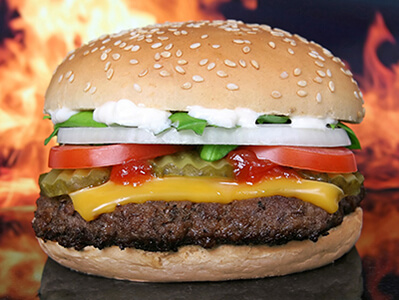This is a lesson summary. The full lesson can be viewed by purchasing an online course subscription.
Learning Objective
In this lesson we will learn about the digestive system in humans and compare it to other animals.
Learning Outcomes
By the end of this lesson you will be able to:
- Discuss the overall function of the digestive system.
- Describe the steps involved in digestion.
- Describe the organs of the digestive system and discuss the role they play in digestion.
- Compare digestion in humans with digestion in herbivores and carnivores.

(Image: Shutterbug75, Pixabay)
Lesson Summary
- The process whereby the body converts food into a form that it can use is called digestion.
- There are five major steps involved in digestion.
- Ingestion – the taking in of food.
- Mechanical digestion – the physical breakdown of food.
- Chemical digestion – the chemical breakdown of food.
- Absorption – the movement of digested food into the bloodstream.
- Defecation – the removal of waste products.
- The digestive system is a group of organs that work together to perform the process of digestion.
- During the process of digestion, food passes through the alimentary canal (gastrointestinal tract) that begins with the mouth and ends with the anus.
- The movement of food through the alimentary canal is achieved by muscular contractions called peristalsis.
- Organs that form part of the alimentary canal are:
- The oral cavity (mouth) – the entry point of food, containing teeth for physical breakdown of food and the tongue for mixing food into a bolus.
- The pharynx – a short tubular section connecting the oral cavity to the oesophagus (as well as the trachea).
- The oesophagus – a muscular tube connecting the pharynx to the stomach.
- The stomach – a large J-shaped sac located in the abdomen that continues the physical breakdown of food and begins the chemical digestion of protein; it secretes gastric juice – a combination of mucus, digestive enzymes and hydrochloric acid.
- The small intestine – a long, convoluted tube consisting of the duodenum – a short section where chemical digestion is completed – and the jejunum and ileum – long, coiled sections containing villi, where absorption of digested food takes place.
- The large intestine – a folded tube consisting of the colon – where water and electrolytes are absorbed, the rectum – where faeces is stored – and the anus – the exit point for faeces.
- Other organs of the digestive system that are not part of the alimentary canal are:
- Salivary glands – glands located around the jaw that secrete saliva to assist chewing and swallowing, as well as the chemical digestion of carbohydrates.
- The liver – a large organ that produces bile, which solubilises fats.
- The gall bladder – a small pouch where bile is stored.
- The pancreas – a leaf-shaped organ that produces enzymes that digest fats, protein and carbohydrates.
- Herbivores rely on internal microorganisms for the digestion of cellulose.
- Herbivores include hindgut fermenters, which digest cellulose in the caecum, and foregut fermenters, which digest cellulose before it enters the ‘true’ stomach.
- Herbivores usually possess large, flattened teeth for grinding up food.
- Carnivores have simpler and shorter digestive systems than herbivores because meat is much easier to digest than plant material.
- Carnivores usually possess long, sharp teeth for tearing and cutting meat.

(Image: Acabashi, Wikimedia Commons)
(Header image: magicmine, Adobe Stock)
